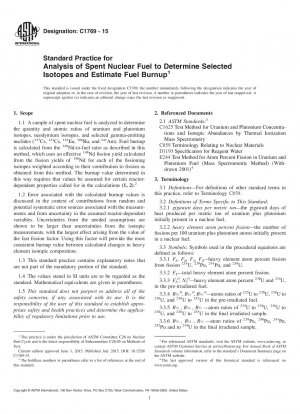ASTM C1769-15
Standard Practice for Analysis of Spent Nuclear Fuel to Determine Selected Isotopes and Estimate Fuel Burnup
- Standard No.
- ASTM C1769-15
- Release Date
- 2015
- Published By
- American Society for Testing and Materials (ASTM)
- Latest
- ASTM C1769-15
- Scope
5.1 This standard practice defines a measure of heavy element atom percent fission from which the output of heat during irradiation can be estimated.
5.2 This standard practice is restricted in use to samples where accurate pre-irradiation U and Pu isotopic analysis is available. This data should be available from the fuel manufacture.
5.3 The contribution of 238U fast fission is not subject to measurement from isotopic analysis. For reactors in which the majority of fissions are caused by thermal neutrons, the contribution may be estimated from the fast fission factors, ε, found in each reactor design document.
5.4 In post-irradiation isotopic analysis, take extreme care to avoid environmental uranium contamination of the sample. This is simplified by using sample sizes in which the amount of each uranium isotope is more than 1000 times the levels observed in a blank carried through the complete chemistry and mass spectrometry procedure employed.
5.5 Take care to make sure that both the pre-irradiation and the post-irradiation samples analyzed are representative. In the pre-irradiation fuel, the 235U and 236U atom ratio content may vary from lot to lot. 236U is not found in naturally uranium in measurable quantity (<2 ppm of a u basis) but forms during irradiation and increases with each successive pass through the fuel cycle. In the post-irradiation examination of a large fuel element, the atom percent fission normally varies radially and axially. Radial and axial profiles of atom percent fission can be determined by analyzing samples obtained from along the radius or axis of the fuel element. An average value of atom percent fission can be obtained by totally dissolving the fuel to be averaged, and then mixing and analyzing an aliquot of the resultant solution.
5.6 The burnup of an irradiated nuclear fuel can be determined from the amount of a fission product formed during irradiation. Among the fission products, 148Nd has the following properties to recommend it as an ideal burnup indicator: (1) It is not volatile. (2) It does not migrate in solid fuels below their recrystallization temperature. (3) It has no volatile precursors. (4) It is nonradioactive and requires no decay corrections. (5) It has a low destruction cross section. (6) Formation of 148Nd from adjacent mass chains can be corrected for. (7) It has adequate emission characteristics for mass analysis. (8) Its fission yield is nearly equivalent for 235U and 239Pu. (9) Its fission yield is essentially independent......
ASTM C1769-15 Referenced Document
- ASTM C1625 Standard Test Method for Uranium and Plutonium Concentrations and Isotopic Abundances by Thermal Ionization Mass Spectrometry
- ASTM C859 Standard Terminology Relating to Nuclear Materials
- ASTM D1193 Standard Specification for Reagent Water
- ASTM E244 Test Method for Atom Percent Fission in Uranium and Plutonium Fuel (Mass Spectrometric Method) (Withdrawn 2001)
ASTM C1769-15 history
- 2015 ASTM C1769-15 Standard Practice for Analysis of Spent Nuclear Fuel to Determine Selected Isotopes and Estimate Fuel Burnup

Copyright ©2024 All Rights Reserved